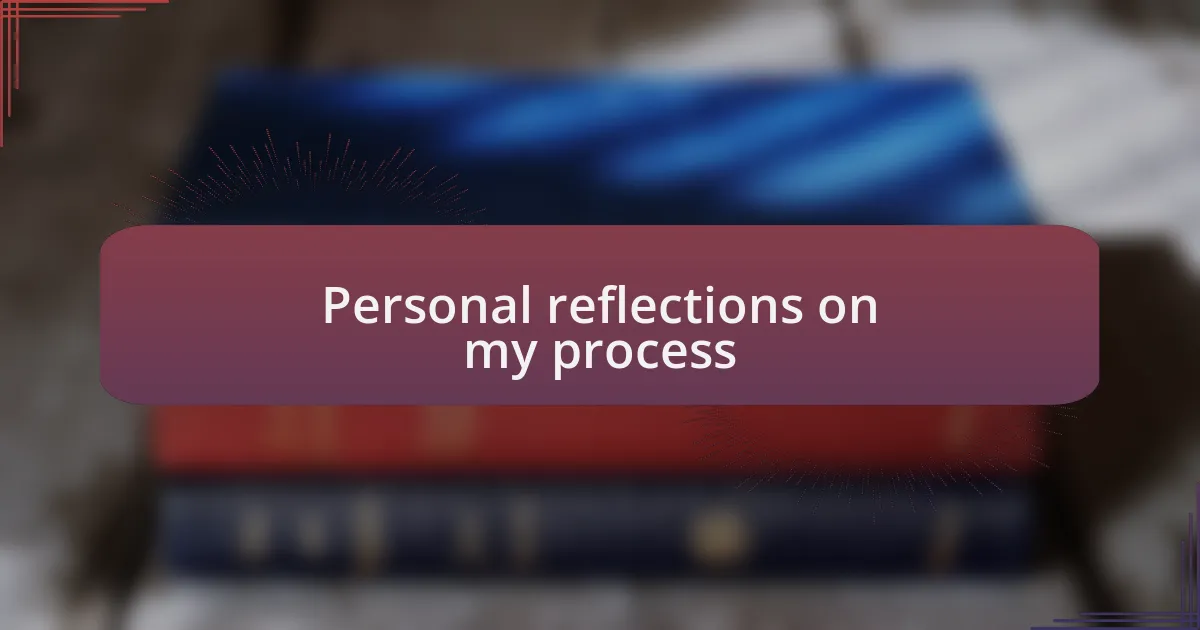Key takeaways:
- Diverse characters enrich storytelling by fostering empathy and offering varied perspectives that challenge stereotypes.
- In-depth research and engagement with different cultures are essential for authentically portraying diverse backgrounds in characters.
- Creating realistic characters involves emotional authenticity and complexity, allowing readers to connect with their struggles and triumphs.
- Avoiding stereotypes requires challenging biases and understanding characters’ unique motivations, leading to more relatable and nuanced portrayals.

Understanding diverse characters
Diverse characters are essential for creating stories that resonate with a wide range of readers. I remember the first time I encountered a character from a background different from my own; it opened my eyes to experiences I had never considered. Isn’t it fascinating how a single story can bridge gaps between different lives and cultures?
When I write, I focus on the backstory of each character, recognizing that their identity shapes how they perceive the world around them. This is a crucial aspect that adds layers to their personality. For instance, a character who navigates life as a first-generation immigrant carries unique challenges and dreams. What would their daily struggles look like? How do their cultural values influence their decisions?
Engaging with diverse characters allows readers to explore their own biases and reflections. I often find myself asking, how can I challenge stereotypes while portraying the rich complexity of a character? This understanding helps me create characters that are not just representative but also authentically human, with hopes, fears, and aspirations that everyone can relate to, regardless of background.

Importance of diverse characters
Diverse characters play a crucial role in reflecting our world’s multifaceted nature. I recall a book where the protagonist struggled with her cultural identity; that journey resonated deeply with me, as it mirrored some of my own experiences navigating cultural expectations. It made me wonder—how many readers might find solace and validation in characters that mirror their own stories?
In my own writing, I often think about the perspectives I might overlook by not including varied backgrounds. Each character can introduce readers to new viewpoints, breaking down the walls of misunderstanding and fostering empathy. I’ve found that when I write characters from different walks of life, it challenges me to think outside my own experiences. It makes me ask, what truths can I capture through their eyes?
Moreover, these characters not only enrich the narrative but also invite readers into conversations about inclusion and representation. I remember my excitement after reading a novel where a character’s journey prompted me to reconsider my biases and assumptions. It’s a powerful reminder that a story is more than just entertainment; it can be a catalyst for change in how we understand each other.

Researching diverse backgrounds
When I embark on the journey of writing diverse characters, I dive deep into researching various backgrounds. I remember a specific project where I wanted to portray a character from a culture vastly different from mine. I immersed myself in documentaries, culinary traditions, and even attended cultural festivals to grasp the nuances of their experiences. Isn’t it remarkable how much understanding can be gained simply by engaging with the community?
I also find that conversing with individuals from different backgrounds adds layers to my understanding. Just a few months ago, I sat down with a friend who shared stories of her family’s immigration journey, and it changed my perspective drastically. Those personal narratives are gold mines of insight; they invite readers to step into someone else’s shoes. Have you ever experienced a moment when a story opened your eyes to an entirely new world?
Furthermore, exploring literature written by authors from diverse backgrounds has been a game changer for me. I often seek out these works to uncover authentic voices and viewpoints, which enrich my own understanding of representation. By analyzing how these authors weave their own cultural contexts into their narratives, I learn techniques that help me create more nuanced characters. Isn’t it fascinating how literature can transcend personal boundaries and connect us all?

Creating realistic character traits
When it comes to creating realistic character traits, I always start by thinking about emotional authenticity. I recall a time when I was crafting a character who was navigating grief. To get it right, I reflected on my own experiences with loss and also listened to others share their stories. This blend of personal reflection and empathy truly deepened the character’s emotional landscape, making it relatable and genuine. Have you ever read a character whose pain felt so real that it resonated with your own experiences?
I also believe in the power of contradictions in character traits. A character who is fiercely independent might occasionally crave connection, just as I’ve seen in friends who struggle between wanting solitude and seeking companionship. Embracing these complexities creates a richer portrayal. It reminds readers that everyone is multi-faceted; we’re all a mix of strengths and vulnerabilities. Isn’t that what makes us human?
Lastly, I focus on the details that ground a character in their unique reality. Take, for example, the way someone might express joy through specific gestures or phrases tied to their culture. I remember developing a character whose family had unique traditions for celebrations; I drew inspiration from my childhood memories of family gatherings where the air was filled with laughter and the rich scent of home-cooked meals. These traits create resonance, allowing readers to connect with the character on a personal level. Wouldn’t you agree that the little details often leave the biggest impact?

Developing unique voices
To develop unique voices, I find it essential to listen to the rhythms of speech that define different characters. For instance, I was once inspired by a close friend whose way of telling stories is peppered with humor and quirky anecdotes. I started mimicking aspects of that style in one of my characters, which gave her a vibrancy that felt genuine and distinct. Have you noticed how some characters stick in your mind simply because of their unique way of expressing themselves?
Another technique I embrace is understanding the background and life experiences that shape a character’s voice. I remember creating a character from a small coastal town, so to capture that authenticity, I drew from my own experiences visiting quaint places. The character’s dialogue included regional slang and references to local customs, which added a layer of credibility. Isn’t it fascinating how a person’s environment influences their communication?
Moreover, I pay attention to how emotions influence voice. There’s a palpable difference in how a character might express frustration compared to joy. I once wrote a scene where a character was filled with rage; their dialogue became sharper and more fragmented, reflecting their inner turmoil. This emotional nuance creates a dynamic voice that readers can easily interpret. How do you think capturing these emotional shifts enhances a character’s presence on the page?

Avoiding stereotypes in writing
When it comes to avoiding stereotypes in writing, I firmly believe it’s crucial to look beyond what’s traditionally expected. I recall working on a character who was a single mother; rather than leaning into clichés of hardship or strife, I chose to portray her as a vibrant, ambitious woman chasing her dreams while balancing parenthood. This decision not only created a more rounded character but also reflected a more realistic experience. Have you ever thought about how a single characteristic can bring depth when you resist the urge to conform?
Another important aspect I’ve learned is to challenge my own biases. There was a time when I found myself resorting to familiar tropes while drafting a character from a different culture. Instead of relying on preconceived notions, I immersed myself in research and sought input from individuals who belonged to that culture. This approach led to richer storytelling and, importantly, allowed me to portray my character authentically. How often do you take the time to delve into different perspectives before writing about them?
Furthermore, character motivations should be as complex and unique as the individuals they represent. I once created a character who was portrayed as the “tough guy.” But rather than just showing a hardened exterior, I explored the warmth he had for his family and the vulnerability hiding underneath. It made him relatable and human, steering clear from the stereotype of a one-dimensional tough guy. Isn’t it intriguing how much more engaging a character becomes when their layers are unveiled?

Personal reflections on my process
One aspect of my writing process that I’ve reflected on is the importance of empathy in character development. I remember drafting a character who was navigating the complexities of anxiety. Instead of simply labeling her as “an anxious person,” I drew on my own experiences with stress and uncertainty, allowing her to become a multi-faceted character whose fears felt real and relatable. Have you ever considered how your own feelings can enhance the depth of a character?
Another key reflection has been the way I approach dialogue. Initially, I often found myself relying on generic conversations that felt forced or unrealistic. It wasn’t until I had a conversation with a friend about the nuances of everyday interaction that I realized the value of capturing authentic voice. This led me to incorporate dialects and speech patterns that reflect their backgrounds. Doesn’t it make a difference when characters sound like real people?
Lastly, I’ve found that revisiting my own work is where the magic truly happens. There was a time when a character of mine didn’t resonate as I’d hoped. Upon rereading, I recognized the missed opportunities for deeper insights into her fears and aspirations. By revising her backstory and motivations, I was able to transform her into a character that genuinely connects with readers. How many times have you revisited your work to find hidden gems waiting to be uncovered?